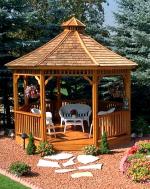

Please click above on this sponsor's banner to see their unique products.
Their sponsorship allows me to continue to provide my web site for you.
Thank you for your support and for visiting my web site.
Search engine visitors - click here to access entire "$ensible Home" web site


Please click above on this sponsor's banner to see their unique products.
Their sponsorship allows me to continue to provide my web site for you.
Thank you for your support and for visiting my web site.
Related links - Do-It-Yourself Deck Design Construction Guide
Click here to see a descriptive illustration showing several designs of gazebos and a solar deck.
Dear Jim: My concrete patio is cracked and I want to build a deck instead. Sometimes the patio gets almost too hot to use. How can I design a deck to stay cooler and shade the house for lower air-conditioning bills? - Bob M.

A: A hot concrete patio radiates its heat back up to your house walls and in through windows. This increases the air-conditioning load. Concrete also has high thermal mass, so it continues to give off heat well into the evening making the air above it and adjacent to the house warmer.
Anything you can do, such as eliminating an uncomfortably hot patio or building an efficient wood deck, that allows you to be outdoors more often saves energy. Whenever you are outdoors, you will not have to keep your house as cool indoors and this reduces air-conditioning costs.
Building a wood deck with a sun deflecting side is your best and most efficient design. Build the deck floor high enough so at least one side is several inches above the ground to allow for cool air flow beneath it.
The key to an efficient deck is creating a vertical barrier which shades the deck and the house wall without blocking natural breezes. The design of the vertical barrier will vary depending on which direction the deck faces.
Install vertical posts along the side facing the sun. Use six or eight-inch wide lumber to make horizontal louvers. Tilt them so the most intense summer sun is blocked from striking the deck and your house wall. If you tilt them properly for your area, the lower winter sun will shine through.
Another simpler option is to install sun-control screening across the vertical posts. This type of screening blocks up to 70 percent of the sun's heat, yet it will still allow a breeze through it and a reasonable view of the yard. This is important if you have children.
The best way to install screening is with do-it-yourself screen framing kits. A support strip is screwed to the posts and top and bottom cross pieces. The screen is placed over this strip and a finishing cap is snapped over it to trap the screening in place. You can remove the screening during the winter for more sun.
For greater efficiency, especially for shading the house, cover the top of the deck with additional tilted wooden louvers or just flat narrow wood strips. These can be spaced closer together because they will not impede breezes. Tilt the louvers properly so the winter sun shines through.
Another way to enjoy more non-air-conditioning outdoor time is building a screened gazebo kit. Precut kits include all the individual pieces. Modular kits have eight roof, wall and floor sections completed for quick assembly.
Instant Download Update Bulletin No. 732 - buyer's guide of 11 screening/frame and gazebo kit manufacturers listing sizes, materials (wood or vinyl), features, illustrations, detailed instructions with diagrams, dimensions and required materials list for building a solar deck and a solar positioning chart for 58 cities.
Dear Jim: I have a lamp by my bed, but it is not bright enough to read well. The fixture indicates 75 watts maximum. Will it really harm anything if I put a 100-watt light bulb in the lamp instead? - Beth L.
A: You should never install a bulb of a higher wattage than is indicated on the fixture. Almost all of the electricity a light uses ends up as heat. A larger bulb may overheat the fixture and become a fire hazard.
If you want to be able to read easier, replace the 75-watt bulb with a full-spectrum compact fluorescent Ott-Lite bulb. It will save electricity and make it much easier to see high-contrast items such as type on a page.